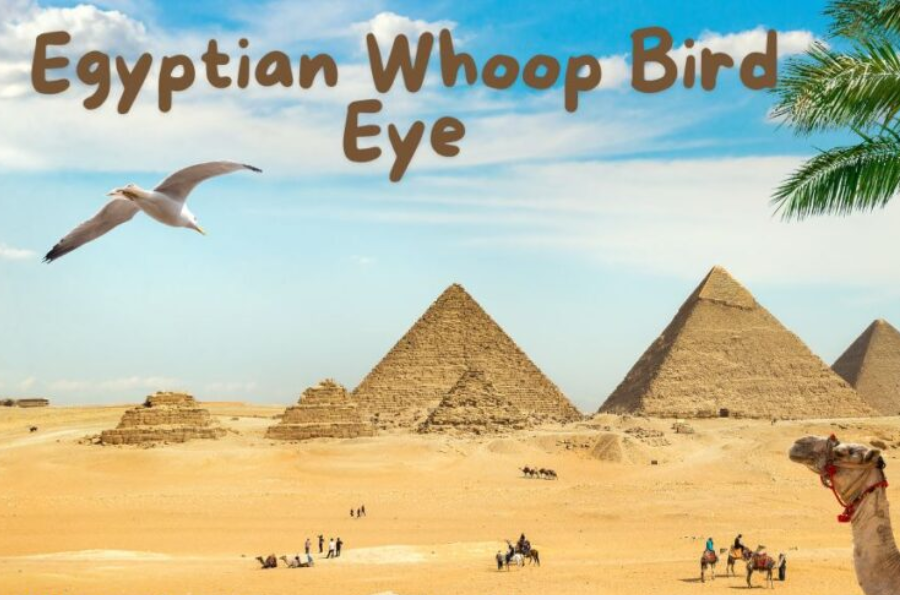Egyptian Whoop Bird Eye: Nature’s Fascinating Mystery
The Egyptian whoop bird eye is a captivating feature of a bird known for its distinct call and unique appearance. These eyes have intrigued nature enthusiasts, historians, and cultural experts for centuries. This article dives deep into what makes the Egyptian whoop bird eye so special, covering its biology, cultural importance, and ongoing fascination among bird watchers today.
Overview of the Egyptian Whoop Bird
The Egyptian whoop bird, also known as the whoop owl, is a remarkable species native to the dry and semi-arid regions of Egypt. This bird is famous for its distinctive rhythmic “whoop” sound that resonates across the desert landscapes, making it a well-known species among locals and birdwatchers alike.
The Egyptian whoop bird is medium-sized, sporting feathers that blend shades of brown, white, and yellow, which provide effective camouflage against rocky terrains. This adaptation is crucial for survival, allowing the bird to hide from both predators and potential prey.
Adapted for life in arid environments, the Egyptian whoop bird is an exceptional flyer, capable of covering extensive distances in search of food. It primarily feeds on insects and small reptiles, which it skillfully hunts during the early morning or evening hours. The bird’s acute sense of hearing and sharp eyesight contribute to its success as a hunter, making it an integral part of the ecosystem in which it resides.
Anatomy of the Egyptian Whoop Bird’s Eye
The eye of the Egyptian whoop bird is a true marvel of nature. With large, rounded eyes, it possesses a wide field of vision, which is crucial for spotting potential prey from great distances. This anatomical feature makes the whoop bird a highly skilled hunter, able to detect even the slightest movements in its surroundings.
Beyond its expansive visual range, the Egyptian whoop bird eye is equipped with a high concentration of photoreceptor cells, enabling the bird to focus on distant objects with remarkable clarity. This capability is particularly useful when gliding above the ground, as the bird scans the desert floor for food.
An additional remarkable trait of the whoop bird’s eye is the presence of a reflective layer called the tapetum lucidum. This specialized layer enhances its night vision, allowing the bird to be an effective hunter during low-light conditions. The combination of wide vision, sharp focus, and enhanced night vision makes the Egyptian whoop bird’s eye an essential tool for survival in the challenging environment of Egypt’s deserts.
Vision Capabilities: The Hunter’s Edge
The Egyptian whoop bird’s eye serves as more than just a means of seeing; it is a powerful tool that facilitates effective hunting. The keen eyesight of this bird allows it to spot prey from long distances, giving it a significant advantage when pursuing small animals.
As the bird soars gracefully above the desert landscape, it can detect even the faintest movements, such as a beetle crawling or a lizard slipping through the sand.
A key advantage of the Egyptian whoop bird is its binocular vision, which helps it accurately judge distances—a crucial skill when diving to catch prey. Unlike some other bird species that may rely on cooperative hunting strategies or scavenging for food, the whoop bird primarily hunts solo. Its success depends on the accuracy and precision of its visual capabilities, underscoring the importance of its exceptional eyesight for survival.
Symbolism of the Egyptian Whoop Bird’s Eye in Egyptian Culture
The eye of the Egyptian whoop bird holds a significant place in Egyptian culture and mythology. In ancient Egypt, birds often symbolized messengers between the human realm and the divine. The whoop bird, with its intense gaze and watchful demeanor, became a symbol of deep insight and perception.
Ancient Egyptians revered the whoop bird for its resilience and adaptability. They believed that the bird’s eye possessed protective powers, capable of warding off evil and bringing good fortune. This belief likely stemmed from the bird’s alert nature, serving as a reminder of the gods’ vigilance over humanity. The whoop bird’s eye was often depicted in art and literature, reinforcing its status as a symbol of wisdom and protection.
Furthermore, the whoop bird was associated with various deities in Egyptian mythology, embodying qualities such as strength, survival, and insight. The portrayal of the whoop bird in hieroglyphics and ancient texts highlights the deep connection that Egyptians had with nature and the way they interpreted the world around them.
Modern Interest in the Egyptian Whoop Bird
Today, the Egyptian whoop bird eye remains a source of fascination for birdwatchers, photographers, and researchers alike. Nature enthusiasts from around the globe travel to Egypt’s remote regions in hopes of catching a glimpse of this elusive bird and its expressive eyes. Often described as curious and enigmatic, the Egyptian whoop bird is a favorite subject for wildlife photography.
In recent years, there has been a growing awareness of the conservation needs of the Egyptian whoop bird. As its natural habitat faces threats from climate change and human activities, conservation efforts have become increasingly important. Organizations and local communities are working together to protect the bird and its environment, ensuring that future generations can appreciate its beauty and ecological significance.
This renewed focus on conservation has not only drawn attention to the Egyptian whoop bird but has also highlighted the intricate relationships between species and their habitats. Efforts to preserve the bird’s natural environment contribute to the overall health of the ecosystems in which they thrive.
Conservation Status: Challenges and Hope
The Egyptian whoop bird is currently classified as a species of concern due to habitat loss and shifting environmental conditions. As urbanization and climate change alter Egypt’s landscapes, the habitats where these birds thrive are shrinking. Conservationists are actively working to establish protected areas where the whoop bird can continue to survive and thrive.
These conservation efforts emphasize the importance of preserving the entire ecosystem that supports the Egyptian whoop bird’s life cycle, including wetlands and desert areas where it finds food and shelter. Engaging local communities is key to these efforts, as raising awareness about the bird’s cultural and ecological value can foster support for its protection. The whoop bird serves as a powerful symbol of resilience, reminding us of the need to protect the natural world and its inhabitants.
Fun Facts About the Egyptian Whoop Bird’s Eye
The Egyptian whoop bird eye isn’t just fascinating for its biological traits—it’s also surrounded by interesting facts that capture the imagination:
- Night Vision Experts: The Egyptian whoop bird eye has a reflective layer that enhances its sight in low light, making it an adept nighttime hunter.
- Blending In: The natural colors of the Egyptian whoop bird help it blend into its environment, offering protection from predators.
- Expressive Eyes: Birdwatchers often describe the Egyptian whoop bird eye as appearing “thoughtful” or “curious,” adding to its mysterious charm.
- Wide Field of Vision: The placement of the Egyptian whoop bird’s eyes gives it an extensive field of view, perfect for keeping an eye out for threats while searching for food.
- A Sign of Good Luck: In some rural Egyptian communities, spotting a whoop bird is considered a good omen, likely due to its ancient associations with protection and insight.
Conclusion
The Egyptian whoop bird eye offers a window into a world where nature and ancient culture intersect. This bird, with its sharp vision and deep cultural significance, continues to enchant those who study it. Its story serves as a reminder that even in a modern world, nature holds countless mysteries and wonders.
Whether you are drawn to the whoop bird for its ancient symbolism or its unique adaptations, there is no denying its allure. By preserving its natural habitats, we ensure that future generations can continue to marvel at the mystery of the Egyptian whoop bird eye—a true testament to the wonders of nature.
Through understanding and conservation, we can honor the legacy of this remarkable species and its vital role in the ecosystems of Egypt.
FAQs
What makes the Egyptian whoop bird eye special?
The Egyptian whoop bird eye is known for its sharp vision, allowing it to spot prey from great distances. It also has a special reflective layer that enhances its sight in low-light conditions.
Where can you find the Egyptian whoop bird?
This bird primarily inhabits Egypt’s dry regions, especially near wetlands and desert areas where it can find food and build its nests.
Why is the Egyptian whoop bird eye significant in Egyptian culture?
The Egyptian whoop bird eye is seen as a symbol of insight and protection in ancient Egyptian culture. It was believed to possess the ability to see beyond the ordinary and served as a spiritual symbol.
Is the Egyptian whoop bird endangered?
While it’s not classified as endangered, the Egyptian whoop bird faces challenges from habitat loss and climate change, making conservation efforts important for its survival.
Stay connected with the latest news and events from Toronto at torontotimes






